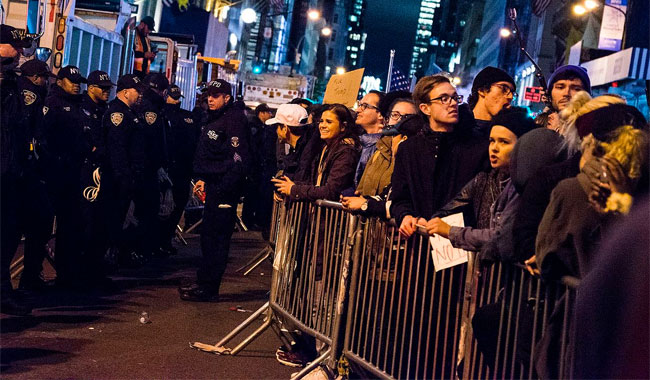A Plea for de Blasio to Support Free Expression With Better Public Spaces

With New Yorkers aching to make themselves heard by the incoming president, a coalition of planning and advocacy groups wants Mayor de Blasio to improve public access to key streets and gathering places. Among other recommendations, the groups urge the mayor to turn Fifth Avenue and 14th Street into pedestrian and transit zones.
The letter, sent to de Blasio last month, outlines seven steps the city can take to accommodate demonstrations and other public events as “New Yorkers come together in greater numbers to celebrate and protect our rights.” It was signed by the Regional Plan Association, Project for Public Spaces, Transportation Alternatives, the Municipal Art Society, and other civic groups.
“As more New Yorkers take to the streets in the coming weeks and months,” the letter reads, “we see a powerful opportunity, and an urgent need, to make strategic improvements to our public spaces — our civic commons — that would make … vital gatherings of free expression safer, more effective, and even welcoming to all New Yorkers who want to participate in civic action.”
On 14th Street, the coalition endorses the car-free PeopleWay concept to prevent traffic from overrunning the area when the L train shuts down. They also recommend pedestrianizing Union Square West, an idea first proposed in 2010 and shelved after NIMBYs complained.
On Fifth Avenue, “There would be no better symbol of the right to the city than to make people and free expression the priority,” the letter reads.
In a Times op-ed published this week, former transportation commissioner Janette Sadik-Khan called on the city to reserve Fifth Avenue for pedestrians and buses:
The change, which should span the stretch of the avenue from Central Park to the Empire State Building at 34th Street, would create a truly American public space: an entirely new civic platform at the nation’s new center of political gravity.
According to AMNY and Politico, Tom Cusick, Fifth Avenue BID president, and Kathy Wylde, president of the Partnership for New York City, oppose getting private vehicles off Fifth, but local City Council Member Dan Garodnick is receptive.
Another key concept in the letter is enhancing public spaces in different parts of the city to foster “hubs of local activism” and make it easier for people to engage with others in their own communities. The letter cites Plaza de las Americas in Washington Heights, Fordham Plaza in the Bronx, and Diversity Plaza in Queens, among others, as examples of spaces that could be used for citywide protest events.
The coalition compiled population numbers and race and income data for areas within a mile of assembly sites in all five boroughs. Here’s their map of racial demographics near the sites:
The coalition also encouraged de Blasio to enlist NYPD to help facilitate mass bike rides, which the letter says would “have a positive overall outcome for Vision Zero, traffic calming and visibility, as well as the obvious effects of gathering and free expression.”






